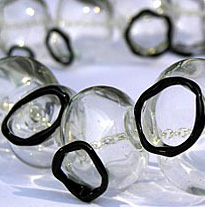

Craft Shows Off Its Skill
Financial Times
By Janice Blackburn
February 4, 2006Copyright 2006 The Financial Times Ltd
This month sees the third anniversary of the annual Collect exhibition of craftwork
at London's Victoria & Albert Museum, providing proof that this collecting field,
once treated with circumspection, now attracts a mainstream audience.
In the early years, introducing clients to a new way of looking at craft was an uphill struggle. I have personal experience of this as between 1997 and 2002 I curated an annual contemporary decorative arts exhibition at Sotheby's in London and New York. Convincing sceptics that the work on show equalled the “real” art that many were avidly collecting provided a fascinating insight into the workings of the art-herd mentality. “Who else is buying?” some would ask, as if that was the only thing that mattered.
Slowly, however, interest grew. The Crafts Council, which had participated for several years at Sofa, the bi-annual American craft show, became aware of increasing activity from an emerging breed of sophisticated craft collectors keen to make inroads into this sector in the UK. The annual Craft Fair at the Chelsea Town Hall (to be enlarged and held at Somerset House from next October) has become hugely popular, though hasn't yet seduced the more discerning and adventurous buyers.
Then, in January 2004, Collect debuted at the V&A, with the four-day event carefully billed as an “international fair for contemporary objects” to avoid using the “craft” word. Several artists showing at Collect had hitherto been hesitant to participate in exhibitions that used the words “decorative” or “applied” in their title, as they were considered to be a terrible stigma.
Perhaps Grayson Perry winning the 2003 Turner Prize with his subversive decorative pots resulted in barriers and prejudice shifting. But, whatever the reason, a total of 42 galleries from Australia, Japan, Israel and Europe have now showcased work by more than 350 artists including ceramics, glass, jewellery, silver and fine metalwork, textiles and furniture at Collect.
Unlike the hordes that mob Frieze and other big art fairs, attendance is relatively modest; 10,000 visitors came to Collect in the first two years and takings were about £1m on each occasion, although follow-up sales continue to flow throughout the year. So what are the highlights of this year's exhibition?
Caroline Broadhead, a jeweller-turned-textile artist and Jerwood Prize winner, deserves better recognition by a wider audience. Her ethereal textile constructions are provocative and surreal with a mysterious, haunting beauty and her installation on show is a must-see.
Thea Burger Fine Art from the US is showing at Collect for the first time. This has created quite a buzz as the gallery represents Ruth Duckworth, a German-born artist working in porcelain, stone and bronze. Duckworth is referred to as “a true alchemist of abstraction” and her soft, serene work appears in numerous public and private collections. She is a good example of the increasing number of artists managing the transition into the fine art arena while keeping a foot loyally in the craft world.
Barrett Marsden, London's big top-end craft gallery, is also showing for the first time. Co-director Juliana Barrett justified the decision to participate this year, commenting that “it will illustrate a comprehensive overview of the rich, inspiring and interesting crafts scene in the UK.” Naturally the gallery also wants to make new contacts to increase its client base.
I am an admirer of several Barrett Marsden artists including potters Gordon Baldwin, Carol McNicoll, and Philip Eglin. Maria van Kesteren's turned wooden objects are also noteworthy.
Several other excellent UK galleries such as Flow, Sarah Myerscough, and Contemporary Applied Arts are returning with selections from their regular artists.
In previous years, jewellery and silver have made the strongest impact on me – and attracted a lot of attention and substantial sales. Be sure to visit three outstanding galleries from the Netherlands: Galerie Ra, which specialises in deceptively playful, highly original work that is ironic and very Dutch (I covet the golden cup made by Karl Fritsch); Louise Smit; and Galerie Marzee (the world's largest gallery for modern jewellery), which both represent top-calibre international artists who explore and challenge new materials in their work, best described as wearable sculpture.
Hannah Peschar's Sculpture Garden has an eclectic selection of contemporary outdoor craftwork, design and sculpture. Norbert Prangenberg's flamboyant painterly ceramic “Figure” caught my imagination and I am also a supporter of ceramicist Rupert Spira, whose work goes from strength to strength. She is exhibiting monumental stone vessels suitable for outdoors.
Another breath of artistic fresh air from the Netherlands is Gallery Terra Delft. How things have moved on since the days when Delft conjured up images of cute china clogs. “Chicken Fever,” an installation of porcelain chicken feet with decals and found objects by Pauline Wiertz, is somewhat offbeat but some collector will appreciate its wit and quirkiness and snap it up.
AIDA, the Association of Israel's Decorative Arts, exhibits intelligent, thoughtful work. Of particular interest is glassmaker Dafna Kaffeman who has produced intriguing objects resembling spiky sea urchins. A simple, rigorously designed table by Alon Eliezer Meron is sharp and cool and proof that rusticity is thankfully a thing of the past.
This year also sees the launch of Collection, a Crafts Council programme of lectures, talks, events and exhibitions, intended to increase knowledge and awareness in “this fascinating and dynamic area of the arts.” Which just goes to show how what was previously disparaged as “craft” now holds its own in the vibrant and flourishing art world.
Collect, the international art fair for contemporary objects (presented by the British Crafts Council), runs from February 9-13, 2006, at the V&A Museum, Cromwell Rd, London SW7; www.craftscouncil.org.uk/collect








